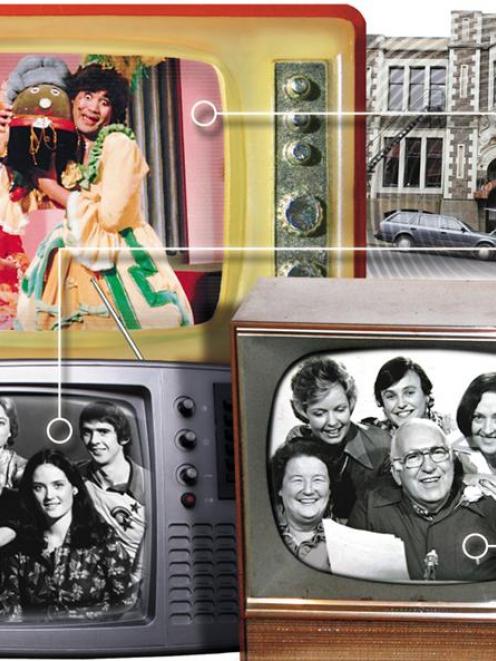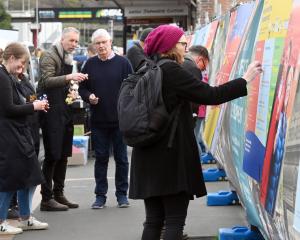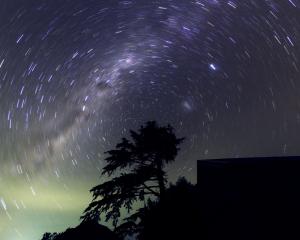
Solidly built into the rock of Bell Hill, Garrison Hall stands redoubtably at the bottom of Dowling St.
Even denuded of its crenellated turrets and flagstaffs, the buttressed foundations, Scottish baronial facade, and the rampant lion and unicorn with the motto "Dieu et mon droit" (God and my right) above the main entrance, proclaim its military origins. But despite the pomp and circumstance of its appearance, for most of its life it has been used for entertainment.
For almost 50 years it has been home to television production. But even from its early days Garrison Hall was one of the city's most important venues for concerts, lectures, early movies, church services, sports, banquets, civic and social functions and meetings, as well as for army drill and military events, the purpose for which it was originally built.
Many celebrities appeared there: Roald Amunsden and Ernest Shackleton gave lectures on their trips to the Antarctic; H. M. Stanley described how he met Livingstone in Africa; famous singers performing there included Nellie Melba and Clara Butt.
Local boy Joe Scott, at the age of 12, became the New Zealand walking champion, beating the Australian champion William Edwards in both 7-mile and 100-mile races. In about 1880 he beat the English champion in a 50-mile race, winning 500 in a 12-hour walk.
"This event, being of international character, excited an extraordinary amount of interest, and Dunedinites were fortunate in arranging the match. Special trains ran from all parts of the land and the Garrison Hall was packed to suffocation, many thousands being unable to gain admission," according to W. F Ingram in The New Zealand Railways Magazine in 1935.
As late as 1948 Garrison Hall was still in use for sports, according to Dave Howell, who joined the New Zealand Broadcasting Service in 1957 and in the 1980s was electronics operations manager at Garrison Hall. He remembers going there as a child with his grandfather to watch men's basketball, sitting in the mezzanine gallery that surrounded three sides of the hall.
From the early 1960s to the end of the 1980s, Garrison Hall was the bustling hub of television studio production and transmission in Dunedin, first for New Zealand Broadcasting and later reorganised as Television New Zealand.
On July 31, 1962, a couple of years after its Auckland debut, the first public television in Dunedin was broadcast from DNTV2 in Garrison Hall. In the early days local news programmes such as Town and Around, the popular Old Time Music Hall, panel games such as You Must Be Joking, quiz shows like Top of the Class, and Alison Holst's cooking shows, were produced there.
According to Michael Stedman, now head of NHNZ, who started working at Garrison Hall in 1964 as a film editor, Hal Weston was responsible for the expansion of the station's productions in the 1970s. Mr Weston succeeded Alf Dick as station manager and turned it into a facility whose production output was at one stage greater than Avalon's, the Wellington television station.
"Hal looked for programmes to produce in Dunedin that weren't seen to be competing with other centres. They wanted to do smart stuff like dramas, but Hal looked for high-volume productions such as Beauty and the Beast and University Challenge. The whole growth of children's programmes - Playschool, Spot On, Viewfinder - was a deliberate strategy. Natural history was a strategy. He left a remarkable legacy," Mr Stedman said.
By 1967, work had expanded and administration and production staff moved out of Garrison Hall to Orbell Chambers in Stuart St, and later to the Methodist Central Mission (now Forsyth Barr) building where news and film staff were also accommodated.
The scenic workshop moved to Fryatt St, leaving Garrison Hall with two studios and their control suites, transmission and video-editing suites, offices for technical staff, electronic workshops, wardrobe and props stores and workshops, and make-up and dressing rooms.
The only time it was actually fortified against attack was during the 1981 Springbok tour protests. A large fence and gate was put across the rear Burlington St entrance to secure the station, but that was removed when the protests died down.
In the 1970s and '80s the main studio and its control rooms were busy six days a week. A smaller studio was used for local news and weather and sometimes advertisements, and there was a busy schedule of outside broadcast productions which included sports and programmes such as Miss New Zealand, Telethon, A Dog's Show, religious music series like Praise Be, quiz shows like University Challenge, game shows like Supersale, and drama series such as Against the Law.
Film was used to capture news and items in magazine programmes such as Spot On and Viewfinder, while the rest of these programmes were recorded on video in the studio. Some documentaries and series, such as Wild South, the early natural history programmes, were entirely shot on film.
The production schedules in the main studio were tight. The sets and lights were changed at night for the next day's programmes.
In the early days there were only enough cameras for one studio at a time, so after working the day in studio three, they had to be moved to studio two for the evening news breakout. In those days it took three men to carry each one up the stairs, according to Lorraine Isaacs who worked in many areas of television over the years, including as station manager at the end of the 1980s.
Playschool occupied the studio for three days each week, recording five programmes. Spot on, a children's educational magazine programme took another day in the studio, and the fifth day was used for other programmes, including Viewfinder a magazine programme for teenagers, Wild Track, a children's natural history programme, A Good Age, a magazine programme for older people, do-it-yourself programmes like Of Course You Can Do It and The Renovators, which featured Dave Cull, now a Dunedin city councillor, The Late Late Show in which figures from the past, such as Beethoven, Breugel or Chaucer were "interviewed", or actor Derek Bolt's Solo, a series of one-man plays about historical writers such as George Orwell, Sheridan and Jonathan Swift. On alternate Saturdays, 10 programmes (two weeks' worth) of Beauty and the Beast, a daily problem-solving panel show, were recorded.
'Playschool'
Playschool, a programme for preschoolers, screened twice a day for about 15 years from 1975. Many New Zealanders could still recite the words to the opening jingle if pushed: "Here's a house. Here's a door. Windows, one, two, three, four . . ."
Two teams of presenters alternated week about in the studio. Over the years, these included Jacqui Hay (now Jacqui Dean, MP for Waitaki), Rawiri Paratene (an actor and writer who has gone on to star in films such as Whale Rider and What Becomes of the Broken Hearted), Barry Dorking (now a Dunedin lawyer), and Winsome Dacker (now a doctor in Gisborne), but the real stars of the show were the Playschool toys, Big Ted, Little Ted, Humpty, Jemima and Manu. They had their own wardrobes, making them some of Dunedin's best dressed.
Playschool was an important training ground for many of TVNZ's trainee directors and scriptwriters, according to Ms Isaacs who, over the years, directed and produced it.
Although in the early days, the concepts and much of the material for the programme came from the BBC, over the years more New Zealand material was included and for most of the '80s it was a completely New Zealand programme with local scripts, stories and films, she said.
'Beauty and the Beast'
Beauty and the Beast was produced for 10 years, from 1976 to 1985, with Selwyn Toogood, of It's In The Bag fame, as anchor and teams of four women each week answering viewers' questions on social issues. Aired at lunchtime, it was one of the last programmes designed for women at home.
"In those days we weren't allowed to discuss politics or religion or abortion law reform. I remember the first time we discussed incest - it was very daring," Ms Isaacs said.
At the time few women featured in public life, but Beauty and the Beast was a vehicle for a large number of New Zealand women, such as Cath Tizard (later Governor-General), Shona McFarlane, Johnny Frisbie, Jean McLean and Iona Williams, some of whom went on to make careers in local or national government or other organisations.
"Those women said they would never have done it if it wasn't for a debut on Beauty and the Beast," Ms Isaacs said.
'Spot On'
Spot On, an award-winning magazine programme for young teenagers, started in 1973 and ran for 15 years, with a variety of presenters, including Ian Taylor, founder of Taylormade Media, Marcus Turner, Margaret Campbell and Danny Watson. They also did "specials" such as stories about Cleopatra, or historical mini-dramas set in places such as Olveston.
The station survived through various reorganisations of government broadcasting into competing channels, TV1 and TV2 in the mid-1970s, reuniting them as Television New Zealand a few years later, but in 1987 restructuring and redundancies meant the station was a shadow of itself, and by 1991, there were about four people covering television news, and the Natural History Unit left in the building, according to Mr Howell.
Under the leadership of Michael Stedman, Natural History picked up the pieces and went from strength to strength making international television documentaries, although few are screened here. In 1997 Television New Zealand divested itself of the unit, which was sold to Fox Television Studios.
After the acquisition, NHNZ acquired Garrison Hall and refitted the interior. Now it is a rabbit warren of offices and editing suites.
Mr Stedman, managing director of NHNZ, jokes he gives visitors a ball of string so they can find their way out again, and that at night you can hear people who are lost scratching on the walls.
NHNZ soon outgrew Garrison Hall, expanding into the top floor of the Commerce building on the corner of Dowling St and Burlington St. Early next year it will move into new premises opposite the Oval.
• In the 1980s Charmian Smith worked for Television New Zealand in Garrison Hall as a wardrobe mistress.












